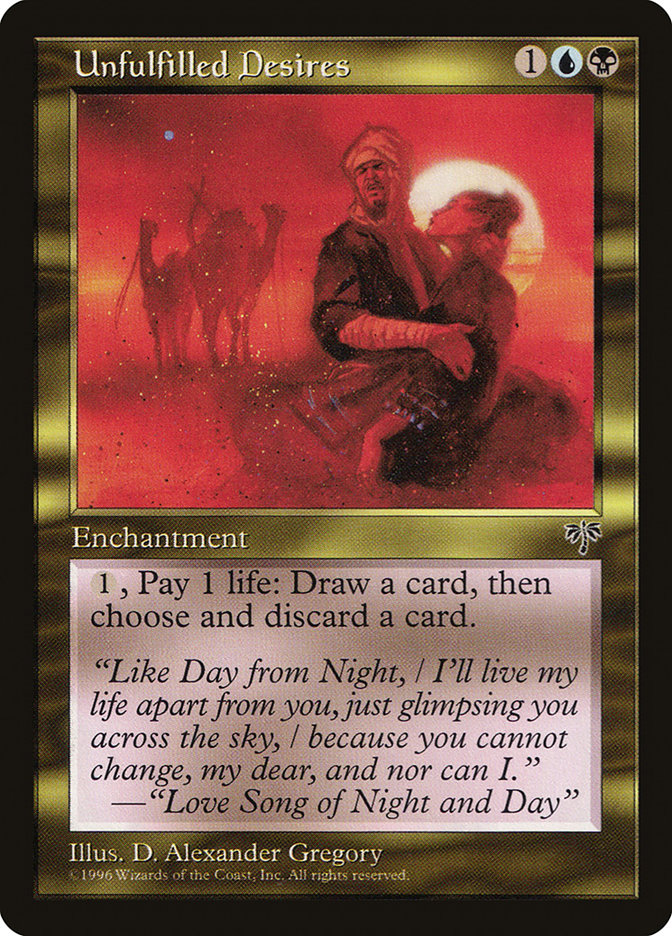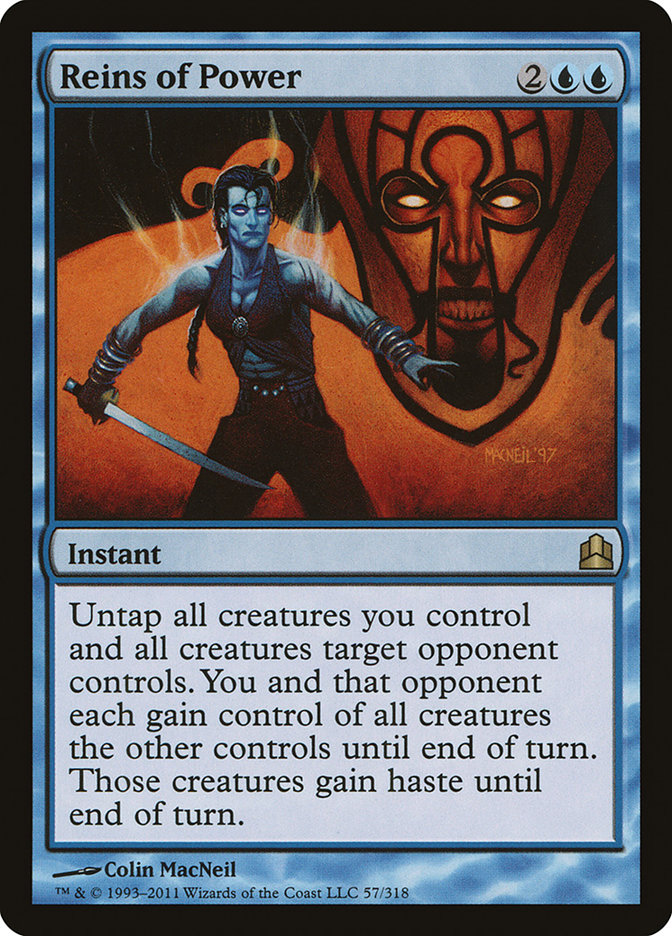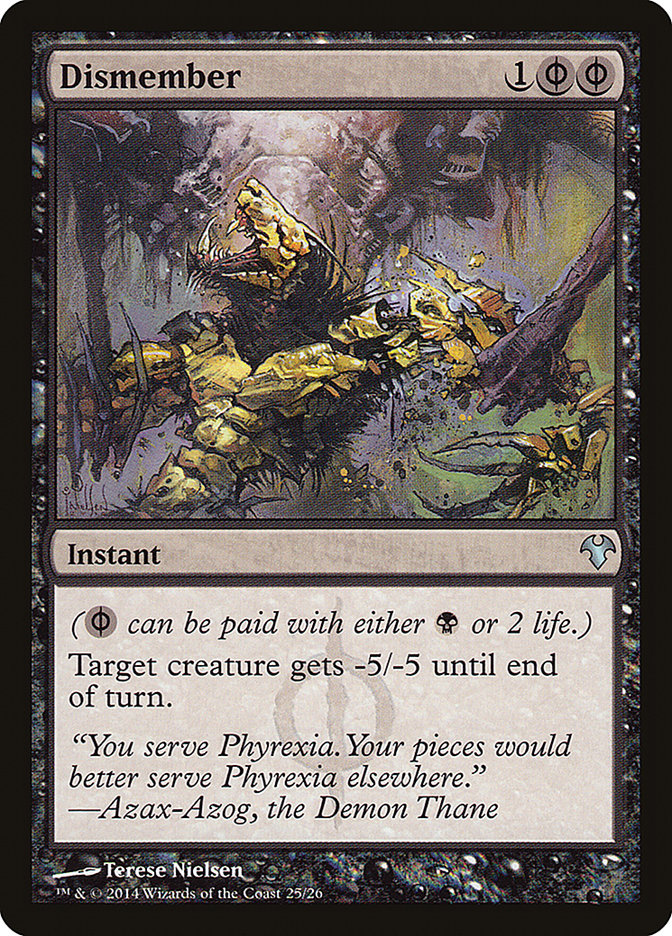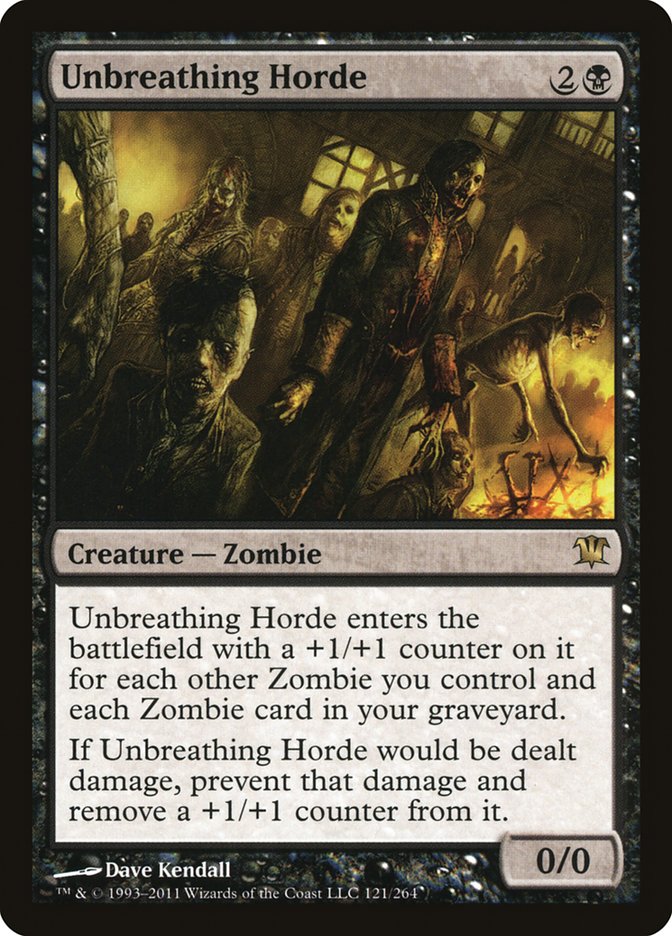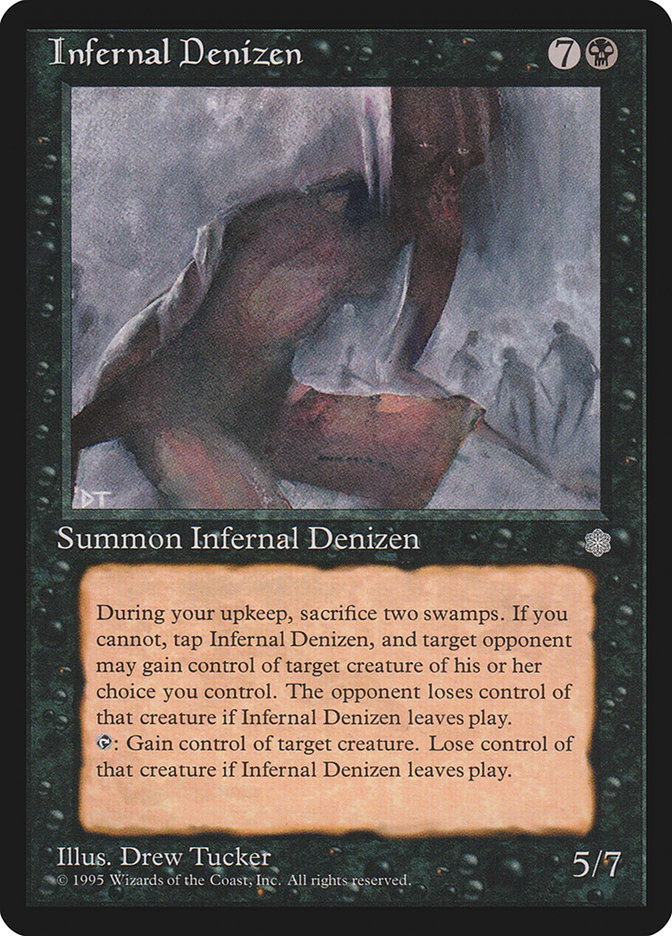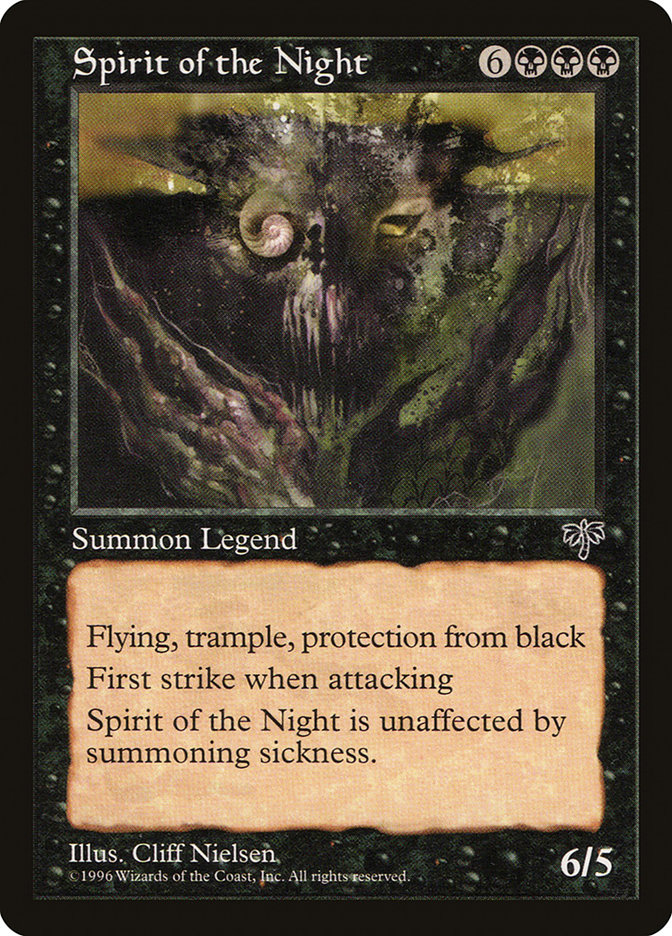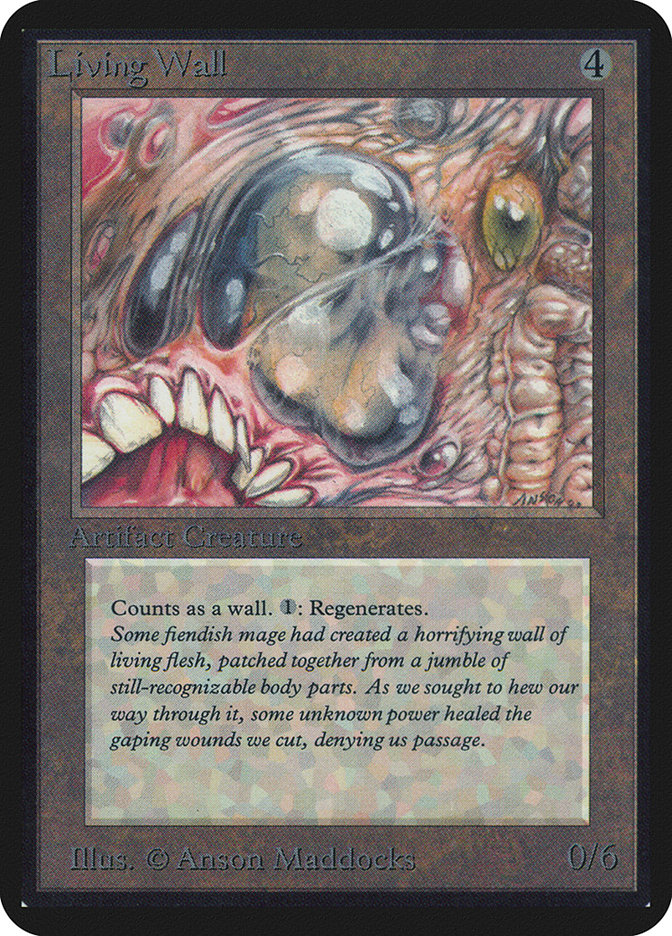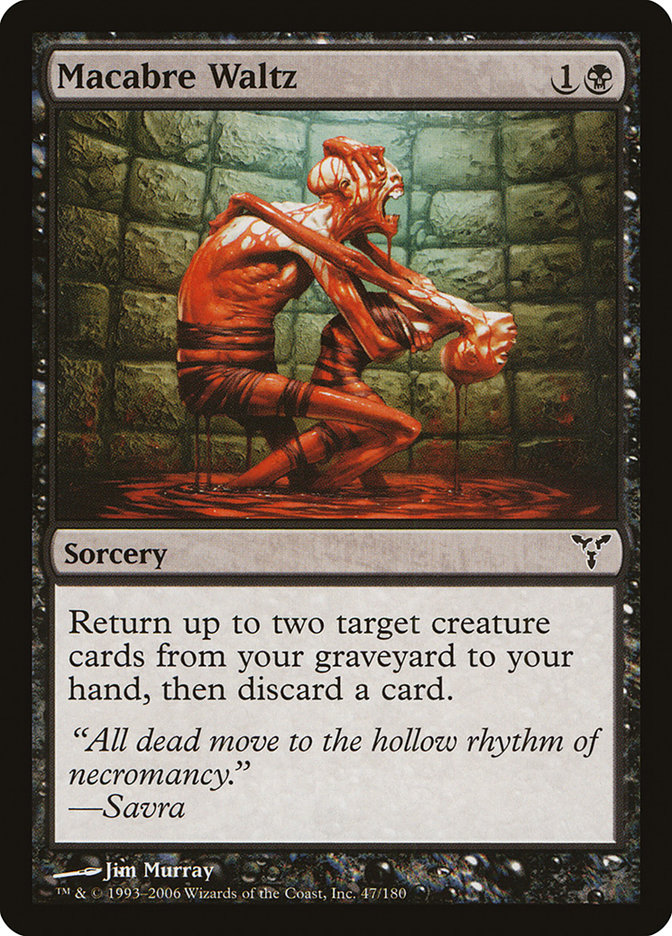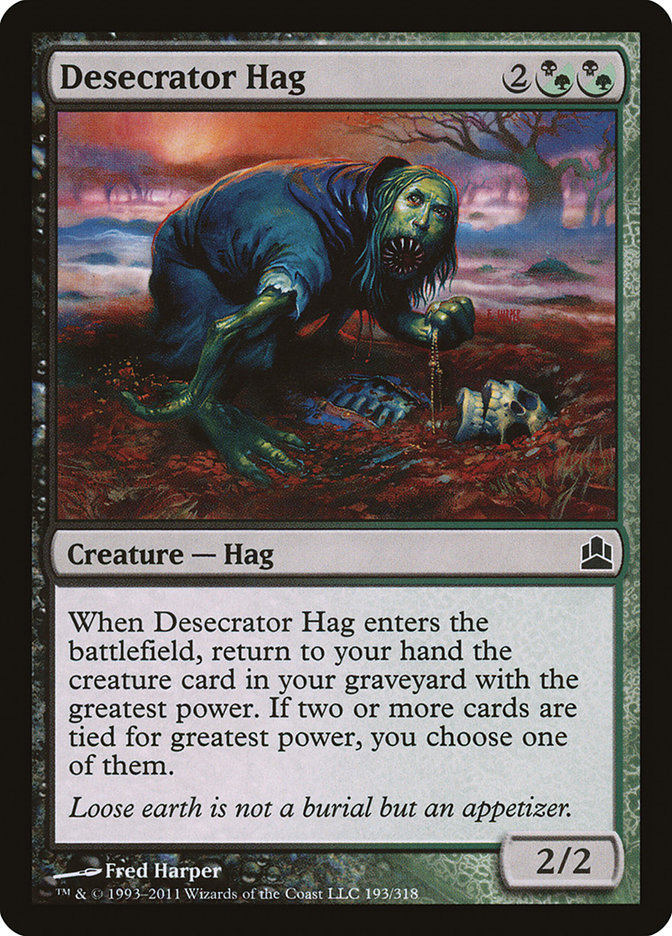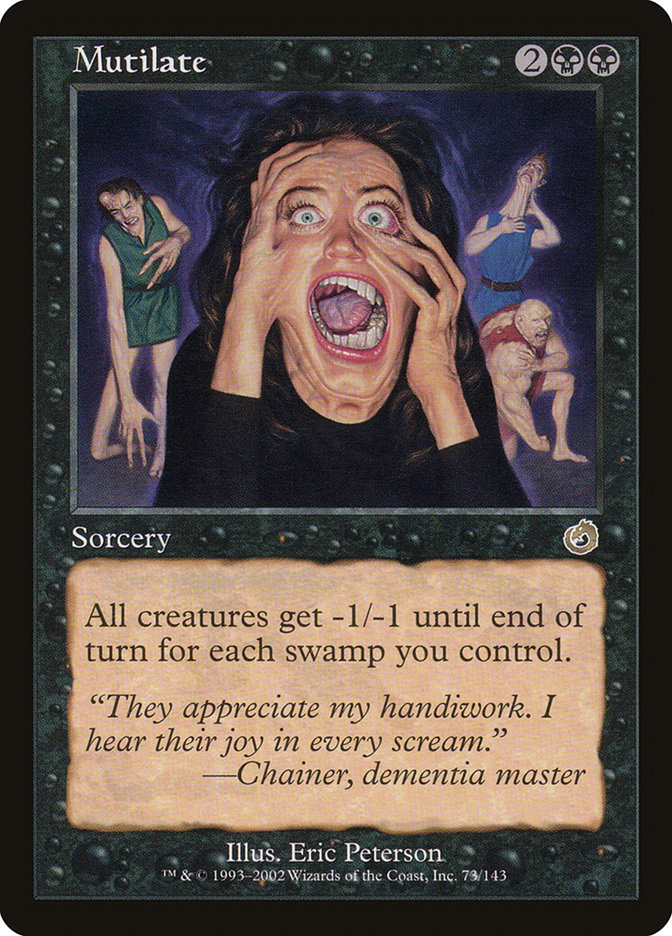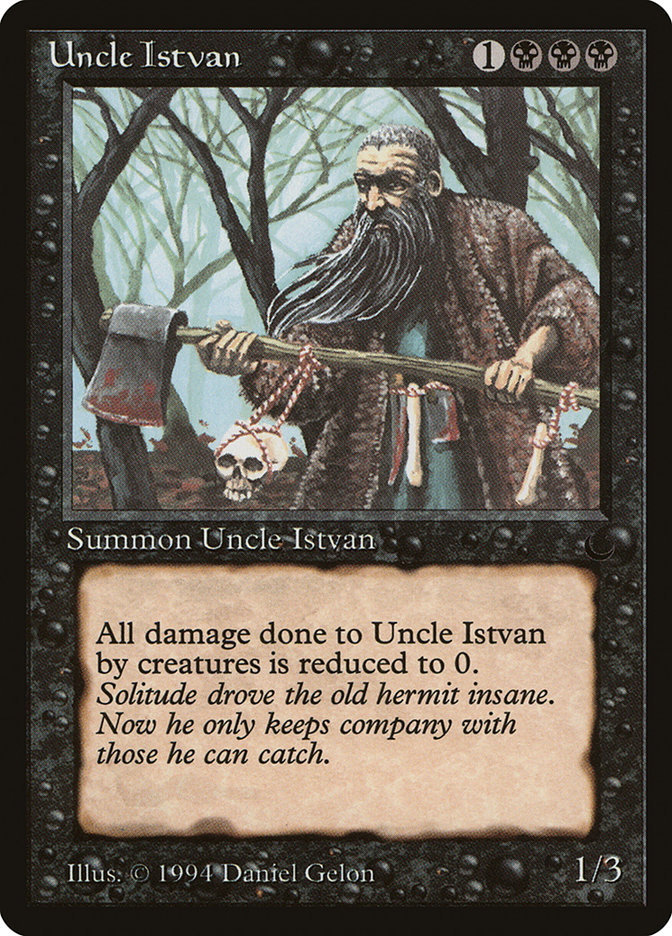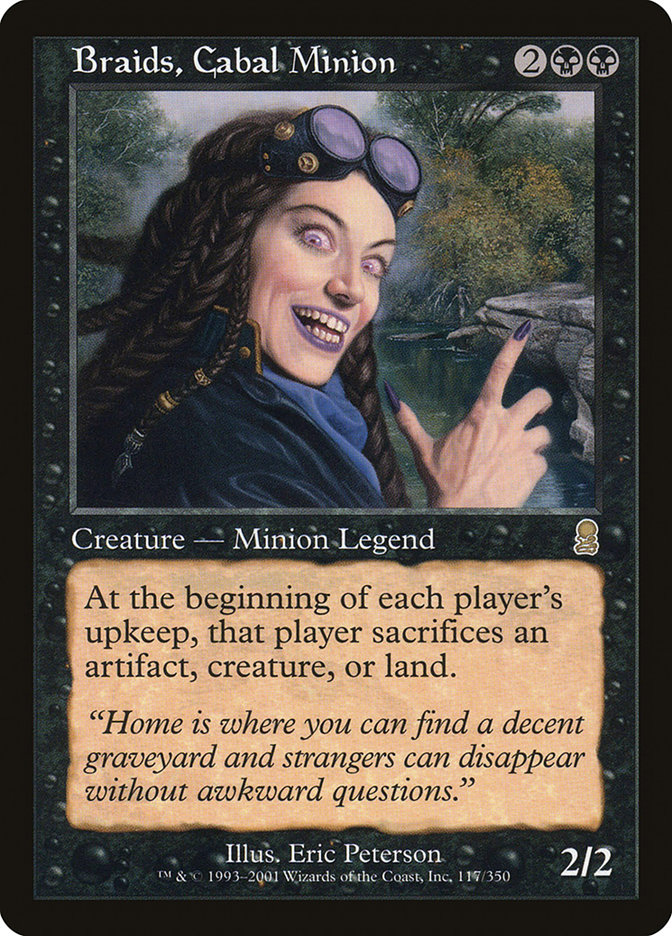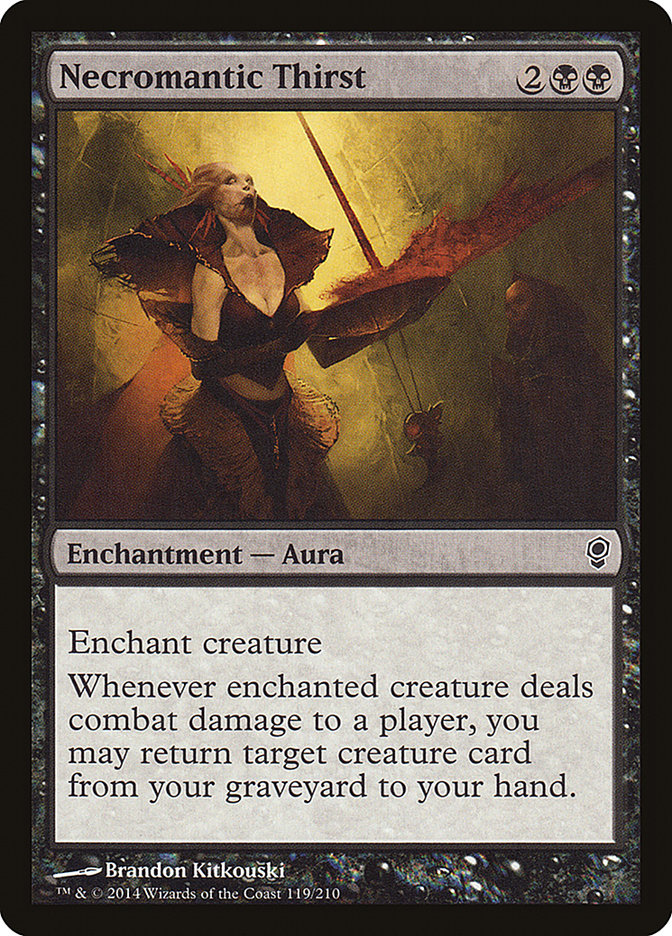It’s that time of year when the air gets colder, the days get shorter, and there is pumpkin-flavored crap positively everywhere. It’s October, which would
be another boring August or September if not for that whole Halloween thing. October gives us the fun holiday that leads into the other holidays that are
family-oriented, and thus, lame. (Christmas is a happy time and all, but it hasn’t been the same since my gifts stopped being video games and started being
utilitarian adult stuff like electric shavers and pajama pants. Remember when you got socks as a kid and it was the one gift that really didn’t do it for
you? When you get old enough, all you get is that gift.)
What’s even more sad is that, right now, I would actually go for some new socks.
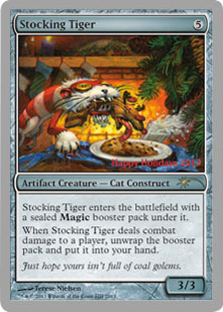
Enough about that. It’s Halloween time, and Magic has a great relationship with Halloween! Today, I’m going to talk to you about the scarier parts of Magic
and share some ways you can enjoy Halloween with Magic in mind. This includes a sweet underrated format that is super cheap to get into.
But first, a Halloween Commander list:
Creatures (29)
- 1 Zombie Master
- 1 Uncle Istvan
- 1 Coffin Queen
- 1 Withered Wretch
- 1 Mortivore
- 1 Graveborn Muse
- 1 Undead Warchief
- 1 Lord of the Undead
- 1 Vengeful Dead
- 1 Gravespawn Sovereign
- 1 Spirit of the Night
- 1 Filth
- 1 Death Baron
- 1 Fleshbag Marauder
- 1 Lich Lord of Unx
- 1 Cemetery Reaper
- 1 Bloodghast
- 1 Viscera Seer
- 1 Grave Titan
- 1 Geth, Lord of the Vault
- 1 Skinrender
- 1 Sheoldred, Whispering One
- 1 Grimgrin, Corpse-Born
- 1 Undead Alchemist
- 1 Unbreathing Horde
- 1 Armored Skaab
- 1 Gravecrawler
- 1 Mikaeus, the Unhallowed
- 1 Diregraf Captain
Planeswalkers (2)
Lands (36)
- 1 Volrath's Stronghold
- 1 Underground River
- 9 Swamp
- 4 Island
- 1 Underground Sea
- 1 Shizo, Death's Storehouse
- 1 Darkwater Catacombs
- 1 Tainted Isle
- 1 Polluted Delta
- 1 Phyrexian Tower
- 1 Lake of the Dead
- 1 Watery Grave
- 1 Urborg, Tomb of Yawgmoth
- 1 Dakmor Salvage
- 1 River of Tears
- 1 Mutavault
- 1 Sunken Ruins
- 1 Drowned Catacomb
- 1 Crypt of Agadeem
- 1 Jwar Isle Refuge
- 1 Creeping Tar Pit
- 1 Halimar Depths
- 1 Command Tower
- 1 Cavern of Souls
- 1 Temple of Deceit
Spells (33)
- 1 Reanimate
- 1 Living Death
- 1 Animate Dead
- 1 Sol Ring
- 1 Demonic Tutor
- 1 All Hallow's Eve
- 1 Grave Pact
- 1 Plague Wind
- 1 Entomb
- 1 Patriarch's Bidding
- 1 Decree of Pain
- 1 Skullclamp
- 1 Phyrexian Arena
- 1 Syphon Mind
- 1 Unfulfilled Desires
- 1 Reins of Power
- 1 Rhystic Study
- 1 Fact or Fiction
- 1 Dimir Signet
- 1 Sudden Spoiling
- 1 Damnation
- 1 Rise from the Grave
- 1 Sign in Blood
- 1 Expedition Map
- 1 Recurring Insight
- 1 Nim Deathmantle
- 1 Black Sun's Zenith
- 1 Blue Sun's Zenith
- 1 Endless Ranks of the Dead
- 1 Army of the Damned
- 1 Zombie Apocalypse
- 1 Increasing Ambition
- 1 Empty the Pits

Grimgrin is a zombie man. People like the zombie people. They’re on television and every video game that has come out in the last ten years has a zombie
mod or expansion or DLC because God forbid someone have a new idea.
This deck can be tweaked any number of ways to fit your playstyle and your playgroup’s power level. I purposefully avoided a lot of generally powerful
cards that you could use because I tried to go all-in on the zombie bit. It’s very tribal but doesn’t play Coat of Arms (because a giant family crest
doesn’t eat flesh and it makes math impossible). There are only a few zombie exceptions just for the sake of doing generally scary things, like reanimating
Sheoldred, Whispering One or casting Demonic Tutor. If you’re willing to go even more lenient on the zombie idea, you could easily just add in more
vampires (Sorin Markov, Bloodline Keeper) or whatever else you deem scary. Personally, I’m terrified of tigers.

“Boo.”
Here are a few winners from the deck you may not be familiar with:
I’m a complete Mirage fanboy. It was on the shelves when I started learning Magic nearly twenty years ago. This card has been outclassed by a lot more
powerful card draw engines by now, but Commander games involve a lot of mana. I figured this would be a good opportunity to break the card back out since
this deck needs card selection and enjoys graveyard play.
If you don’t understand why this card is practically mandatory for a Halloween-based Commander deck, you may be at the wrong website. It’s bedtime grandma.
Go back to your room.
The short of it is, this card is a suspend card that screams instead of suspending. It’s an awkward card, one that somehow manages to be highly fun,
functional, and flavorful while still having that hilarious what-the-hell design you find all over ancient Magic sets.
Another great yesteryear nonsense card. I actually didn’t realize this card had been reprinted in a Commander set (the original was in Stronghold) until
doing research for this build. The primary reason to run this card here is in conjunction with a sac outlet. One of the important aspects of maximizing the
efficiency of your Commander deck is finding cards that cheat the color pie somewhat. Nothing has ever gone wrong by allowing colors access to abilities
they don’t traditionally have.
Cough.
The Reins of Power effect feels fairly red (a mass Act of Treason) despite its tricky blue qualities. I do not take responsibility for awkward top decks
where you draw Living Death after sacrificing all your opponent’s creatures away.
Innistrad replaced The Dark as the quintessential “scary” set a few years ago. The Dark was an early Magic goof set, and frankly, it wasn’t that much more
frightening than Legends. Innistrad has been celebrated to death (correctly, I might add; it’s brilliant and better than your favorite Magic set), but this
card, despite being one of the most amazingly definitive zombie cards, has received little to no love. I love you Unbreathing Horde. You can shamble my way
any time.
The rest of the list is filled out with generally creepy tributes and, of course, more dead people. You can provide all the feedback/ideas you want in the
comments, but first, a special feature:
The 10 Creepiest Magic Cards of All-Time!
10.
Back in the day, Drew Tucker made his living off of semi-abstract, vaguely recognizable art that either disturbed us or made us wonder why Wizards
commissioned a used napkin for a Magic card. This is the one that makes me cry the most.
9.
Spirit of the Night was Akroma before Akroma was Akroma. I like Mirage. Maybe you’ve heard of it.
Creatures (24)
- 1 Spike Weaver
- 1 Verdant Force
- 1 Tradewind Rider
- 4 Wall of Blossoms
- 4 Birds of Paradise
- 1 Man-o'-War
- 2 Nekrataal
- 2 Uktabi Orangutan
- 2 Spike Feeder
- 2 Wall of Roots
- 1 Spirit of the Night
- 1 Orcish Settlers
- 1 Cloudchaser Eagle
- 1 Thrull Surgeon
Lands (22)
Spells (14)
Sideboard

This deck might be my favorite deck in Magic history. And as a quick aside, the date here is estimated as it is nearly impossible to track down good
information on the game’s first few competitive years. Someone should fix that before all the Magic old people (me) lose their memories (any day now).
8.
Anson Maddocks was one of the most important artists of early Magic. He managed to take non-black cards into the same horrific space as the scariest of the
black ones. Maze of Ith is also particularly uncomfortable. As great as the art in Magic is now, there is definitely something lost by no longer having the
gut-wrenching digestive awful that Anson often brought to the table.
7.
This is a common choice for creepiest card art, but I disagree. It certainly belongs in the discussion, but doesn’t the fact that these skinless corpses
are doing a jig negate some of the creepy? To me, it’s more Jack the Pumpkin King creepy than unpleasant death-fearing creepy.
6.
What.
5.
You knew this would be here. This art is such an unbelievable horror home run. It’s one thing to churn out horror tropes, to show guts and bad actors in a
too-familiar formula until the check clears, but it’s another thing to re-think what makes good horror work.
Mutilate works because it manages to take human deformity-a very real and plausible outcome, however unlikely, for anyone getting into their car or having
a child or cooking with a blindfold on-and mix it with uncomfortable surrealism to create something that outscares the most hackneyed ho hum regurgitation
of the same boring gore crap.
It’s unflinchingly horrible. And perfect.
4.
Another inclusion from the Halloween Commander deck from above. This guy not being a legend (The Dark was after Legends so there’s no rules excuse for
this) is such a disservice. How are there multiple Uncle Istvans? Why can’t we play him in Commander? How about a Gatherer update for that? Why is he
invulnerable to creatures? Why must he bring his axe to the dinner table? Where am I?
3.
Madam Braids has been blowing people away since she first came onto the scene as the proposed updated art for Diabolic Tutor. Needless to say, she deserved
better and got it. Although the flavor text is a bit jovial and takes some of her punch out, Braids’s art remains a paragon of creepy excellence.
2.
This gets my vote for the most underrated creepy art in Magic. There is positively nothing good going in that artwork.
1.
Speaking of The Dark, here we have the frequent frontrunner of discussions like this. Maybe it’s the perspective, maybe it’s the setting, or maybe it’s
because we’re all crybabies, but this card has a way of damaging players-and I’m not talking about its in-game ability.
Revisiting The Horde Format
About three or four years ago,
I happened upon an article by Peter Knudson
explaining a very simple to learn and very interesting way to turn Magic into a cooperative survival game. Most multiplayer Magic is political at best and
slow at worst, and this was a way to eliminate those unpleasant characteristics and really expand the way Magic is experienced. Innistrad was also on the
horizon at the time, which made a zombie-oriented theme the best possible way to introduce Horde Magic.
What is Horde Magic?
Horde Magic is a cooperative Magic game where any number of players play against an automated Horde deck to simulate a group of people trying to survive an
onslaught of monsters. You can play with virtually any Magic deck, though it is much better if you tweak it for flavor purposes (more on that below). Each
player needs a deck for themselves. You’ll also need a Horde deck.
The Horde deck consists of a giant stack of tokens (typically zombies) and some number of non-token spells. The game is played with all of the “survivor”
players taking three consecutive turns. This allows them to “set up” and brace for the Horde. After each player has finished their first three turns, they
pass to the Horde. The Horde’s turn consists of flipping cards from the top of the Horde deck until a non-token card is flipped. All of the tokens that
were flipped enter the battlefield. Then the non-token card is cast. After it resolves (or is countered or whatever), all creatures that entered the
battlefield from the Horde deck attack. Players get twenty life per player. When their collective total reaches zero, the players lose. Whenever the Horde
is attacked, the top card of the Horde deck is put into the Horde graveyard. The players win when the Horde deck begins its turn with zero cards left to
flip over and no creatures to attack with.
The best variations on this game are typically done where each player’s life is carried individually. For example, instead of having four players and a
collective 80-point life total, each player starts with their own twenty-point life total. Then each turn, the Horde attacks a different player.
This variation is perfect for Halloween. One of the format’s shortcomings is in its random flavor. It is fun to just build a big Horde deck with lots of
different tokens and cards, but it loses some of its survivalist identity. Additionally, I’ve found that the format works much better with generally
“pre-constructed” decks that allow each Survivor to follow a different strategy. It’s also advisable to help your playgroup customize their Survivor
character/deck by keeping a few extra cards handy. Then, before each Horde game begins, each player can use a pool of 75 or 80 cards or so to build a forty
card deck for themselves.
(As a quick aside, alterist extraordinaire Eric Klug owns a Humans vs. Zombies Cube to the best of my recollection. This is another great way to combine
Magic with people-eating.)
Here is an example of a Horde deck to get you started:
Creatures (39)
- 3 Cackling Fiend
- 1 Soulless One
- 1 Dross Crocodile
- 1 Severed Legion
- 1 Maggot Carrier
- 1 Gluttonous Zombie
- 1 Vengeful Dead
- 1 Noxious Ghoul
- 1 Carrion Wurm
- 1 Infectious Host
- 1 Gristle Grinner
- 1 Mass of Ghouls
- 1 Infectious Horror
- 1 Lightning Reaver
- 1 Vedalken Ghoul
- 1 Thraximundar
- 1 Grixis Grimblade
- 1 Warpath Ghoul
- 1 Zombie Goliath
- 1 Grave Titan
- 4 Contagious Nim
- 1 Nested Ghoul
- 1 Unbreathing Horde
- 1 Rotting Fensnake
- 1 Ghoultree
- 1 Diregraf Captain
- 3 Black Cat
- 1 Highborn Ghoul
- 1 Dread Slaver
- 1 Maalfeld Twins
- 1 Liliana's Reaver
- 1 Rotting Mastodon
Spells (1)

Naturally, you’ll need zombie tokens. For this, I’d recommend about 80. Then I’d add 5 Zombie Giant tokens (from Zendikar) if you want a bit of the
surprise mini-bosses effect. You can tweak your difficulty however you’d like. For example, you may find Plague Wind to be way too much of an auto-lose,
but I prefer to make the game as challenging as humanly (ha!) possible. I feel like if the survivors are winning even 40 or 50% of the time, then the Horde
probably isn’t strong enough.
Now, again, you can play against a Horde with any Magic deck you want, but if you want a super cheap and super flavorful way of playing, may I suggest some
of the following for your survivors:
Creatures (22)
- 1 Fumiko the Lowblood
- 1 Royal Assassin
- 1 Erg Raiders
- 1 Maraxus of Keld
- 1 Jeska, Warrior Adept
- 1 Charging Bandits
- 1 Eron the Relentless
- 1 Opportunist
- 2 Flailing Soldier
- 2 Ghitu Slinger
- 2 Big Game Hunter
- 1 Dunerider Outlaw
- 3 Rathi Trapper
- 1 Riot Ringleader
- 1 Tavern Swindler
- 1 Splatter Thug
- 1 Bane Alley Blackguard
Lands (24)
- 10 Swamp
- 10 Mountain
- 4 Akoum Refuge
Spells (14)

This is the Survivor deck that will do most of the actual zombie killing. It also has a handful of X spells to either finish the game off or create the
sweetest Miracle ever in the appropriately titled Bonfire of the Damned. The deck also has a handful of powerful legends that can take back the game even
after the zombies have grown out of control. The most difficult decisions to make with this deck will be in deciding when to pull the Pyroclasm or
Blockbuster trigger given your boardstate and the creatures controlled by your Survivor allies.
Spells (35)
- 1 Booby Trap
- 2 Bonesplitter
- 1 Thirst for Knowledge
- 1 Loxodon Warhammer
- 1 Fabricate
- 1 Nuisance Engine
- 1 Inspiration
- 1 Reconstruction
- 1 Twitch
- 1 Tinker
- 1 Voltaic Key
- 1 Caltrops
- 1 Engineered Explosives
- 2 Compulsive Research
- 2 Cancel
- 3 Moonglove Extract
- 1 Cloak and Dagger
- 1 Trip Noose
- 2 Courier's Capsule
- 2 Blazing Torch
- 1 Angelheart Vial
- 1 Contagion Engine
- 1 Ratchet Bomb
- 2 Accorder's Shield
- 1 Heavy Arbalest
- 1 Lux Cannon
- 1 Darksteel Plate

This is the Survivor deck that comes up with little inventions and toys to keep the zombies busy. Equipment can be played a few ways. Traditionally, we’ve
had whoever controls the equipment pay the equip costs, but the equipment can then be moved onto any creature the survivors control. That’s one of the big
reasons to include cross-creature type situations like Cloak and Dagger. But, of course, this nonsense isn’t sanctioned, and you can rules tweak however
you prefer to get maximum mileage out of your experience.
These are just two of the many archetypes you can create for this format. We’ve traditionally had a G/W Medic deck that has lots of defensive lifegain
cards, as well as a white weenie Recruiter deck that has Elite Inquisitor, Champion of the Parish, Veteran Armorsmith, and other general “good guys.”
I would advise against playing any cards that create awkward “made up rules” scenarios. For example, Crawlspace is pretty good flavor, but it makes for a
strange situation depending on how you’re handling everything. I’d also recommend not putting in a lot of target effects in the Horde deck. Terror and the
like is great, but even determining the target randomly can get annoying when there are fifteen creatures on the Survivor side, and you only have a couple
of six-sided dice.
That’s it for me this week! I hope you’ve enjoyed this diverse look at the on-again off-again relationship Magic has with Halloween. If anybody has ideas
for either Horde Magic or Grimgrim in Commander, feel free to put them in my trick-or-treat bag. No candy corn please. I’d rather eat human flesh.
Knock knock.

